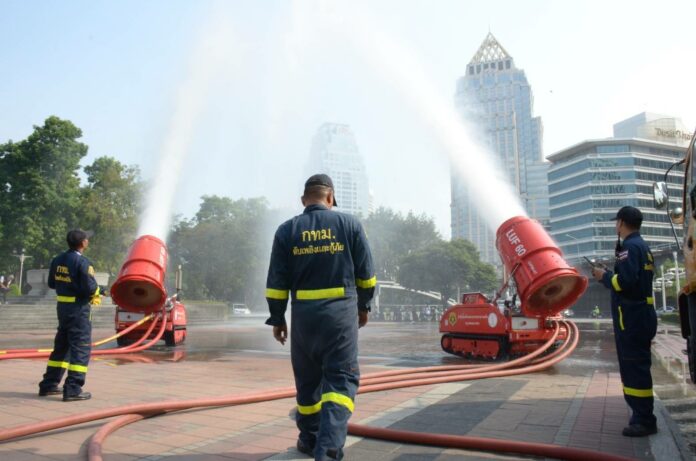
BANGKOK — The capital’s heavy smog has been a chronic problem for years, and the government is still not doing enough to combat it despite the sudden swell of public concern, experts said Tuesday.
Current pollution levels aren’t much worse compared to those of the past few years, a former head of the Pollution Control Department said, adding that measures launched by the authorities such as spraying water and seeding clouds have been tried before without effect.
“The measures implemented last year were the same as this year, and still the smog returned to about the same level,” Supat Wangwongwatana said. “They weren’t a solution, just temporary relief of the situation’s severity.”
Bangkok’s smog is normally heaviest December to January, and Supat said this year only appears much worse because of better data collection and wider scrutiny by traditional and social media.
“The reason we didn’t feel it was this bad in the past was due to the lack of information,” he said, as officials didn’t have enough means to measure the pollution and channels to inform people about it.
However, he said the government must do better than offer a routine response that’s not going to solve the problem, he said.
Following public alarm, City Hall and the government announced several steps to combat the smog that has risen to unhealthy to hazardous levels across the capital since this past weekend. They include hosing down streets, spraying water into the air, dumping water from planes and chemically seeding clouds to create rain.
“It’s like we have the flu and take pills to ease the pain and fever, but the real cause of the problem is still inside our body,” said Supat, who also teaches public health at Thammasat University.
There is a number of policy steps for lasting effects if “the government dares to do it,” he said, such as reducing the number of cars on the roads by rationing their use through an “even and odd” system, better regulating vehicle emissions and stricter control of open burning.
Not a New Problem
The density of ultrafine particles in Bangkok has been about the same since 2014, according to data from the Pollution Control Department. From 2014 to 2017, they peaked on average between 60 micrograms and 95 micrograms per cubic meter. This month, they have registered between 40 micrograms and 90 micrograms. A maximum of 50 micrograms is considered acceptable.
Sirima Panyametheekul, who teaches environmental engineering at Chulalongkorn University, said in a panel discussion at the university yesterday that the smog isn’t new, but it’s aggravated this time of the year due to weather conditions.
Supat, a former pollution control official, agreed with the official diagnosis that diesel emissions are one of the major pollution sources, but said there are many other contributing factors such as open-air burning in the metropolitan area, as well as dust from the many construction projects for everything from large buildings to new rail lines.
And the more we build, the worse it gets, Supat added.
“Bangkok was quite flat and didn’t have that many skyscrapers in the past, so the air from the central area could circulate to the outer areas better,” he said. “Now there are skyscrapers lining up like walls and blocking the air from flowing away.”
Masks quickly became increasingly scarce after pictures of heavy smog were shared widely by the media and on the internet, especially the N95 masks, the type able to filter most of the ultrafine PM2.5 particles considered the smallest and most harmful.
Health officials on Tuesday however urged people in good health not to panic if they can’t find such masks as the particles will cause health problems only after prolonged, repeated and intense exposures over a long period of time.
“Exposure to PM2.5 will not immediately cause acute health problems, but will increase risk [of illness],” said Supakit Sirilak, a top health official. “The idea is to reduce the exposure.”
He said many people still don’t know how to properly use the N95 masks, which aren’t an absolute necessity nor the only means of protection.
“N95 masks can filter over 90 percent of PM2.5, but only when you wear them correctly,” he said. “And even you wear it correctly, you still can’t keep it on for long. After about 20 minutes of wearing one, you won’t be able to breathe comfortably.”
He said people who don’t have health issues or must remain in very smoggy areas for long periods of time, it’s adequate to wear a normal mask, which can filter about half of the particles. Remaining indoors is another way to reduce exposure.
















































